Technology
PROPERTY| ROTATIONAL MOULDING
Rotational molding is an atmospheric pressure process that produces nearly stress-free parts. The fact that there are no stresses on the melt as it is shaped is a major advantage that rotational molding has over all other manufacturing methods for plastics parts. Also, as there are no forces on the plastic melt during forming, rotational molds can have thin walls and are relatively inexpensive to fabricate. For simple parts, mold delivery times can be a few days or weeks. Modern, multi-armed machines allow multiple molds of different sizes and shapes to be run at the same time. With proper mold design, complex parts, such as double-walled containers, that are difficult or impossible to mold by any other method, can be rotationally molded. With correct process control, the wall thickness of rotationally molded parts is quite uniform, unlike structural blow molding or twin-sheet thermoforming.
WALL
The rotational moulding process can be used to mould hollow items, but this does not mean that by the term “hollow item” it is intended to have a large hollow internal volume. It is, in fact, possible to mould “hollow items” that have two walls very close to each other which form a
part that has both the external section and the internal section produced by the mould surface.
Moulds that permit the moulding of a double wall part can be designed with a “core” that defines the inner part.
The distance between the two parallel walls may be relatively small, which makes the parts suitable as isolators for example. In this case, to give the powder the space needed to flow inside the mould, it is necessary to design the two walls with an adequate separation gap.
